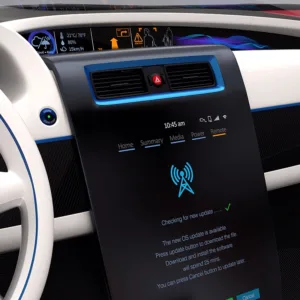In the fast-evolving landscape of display technologies, MicroLED stands out as the next frontier, poised to surpass the capabilities of OLED and reshape the $180 billion display market. Packed with superior characteristics such as ultra-high brightness, low power consumption, high color reproduction, longer lifespan, and wide viewing angles, MicroLED is not just an incremental improvement; it’s a revolution in visual experiences.
MicroLED displays offer many advantages that will redefine the future of display. With additional benefits, including transparency, zero bezel, compatibility with true folding, and advanced micro-semiconductor (e.g., microsensor, micro-AI, microchiplet, etc.) integration, MicroLED transforms into a multifunctional interface beyond being a mere display. One striking feature is the ability to provide extremely high brightness and the perfect black without the looming threat of burn-in, setting it apart in terms of longevity and reliability.
The Secret: Minuscule LEDs and Elimination of Organic Materials
The magic behind MicroLED lies in its utilization of minuscule LEDs to create subpixels, eliminating the need for organic materials. This results in enhanced display performance and contributes to the reduction of environmental impact, aligning with the growing emphasis on sustainability.
MicroLED technology unlocks a realm of creative possibilities previously unattainable with traditional display technologies. The seamless integration of tiny LEDs allows for the creation of displays that are not only visually stunning but also highly functional. From curved and flexible displays to those with unconventional form factors, MicroLED is a canvas for innovation.
Environmental Stewardship: MicroLED’s Green Advantage
In addition to its superior display capabilities, MicroLED has a green advantage over OLED. Research shows that MicroLED fabs consume 30% to 200% less water, power, and materials, significantly reducing their environmental footprint. Further, with 50% to 200% lower power consumption, MicroLED emerges as a sustainable choice in the quest for eco-friendly technologies.
MicroLED isn’t just the next in line; it has the potential to redefine the $180 billion display market. Forecasts indicate that MicroLED alone could reach a market value of $30 billion by the end of the decade with suitable MicroLED transfer technology. The total market potential extends beyond displays, hinting at a $1 trillion valuation.
To understand the potential impact of MicroLED, it’s essential to consider OLEDs growth trajectory. With advancements in fabrication, OLED grew to a $45 billion market in 2023 and is projected to reach an astounding $112 billion by 2030.
The Crucial Role of Transfer Technology
While the future of MicroLED is bright, most investments in MicroLED have focused on devices and structures, neglecting the critical area of transfer technology. This is the primary challenge limiting mass adoption of MicroLED displays.

The crux lies in transferring MicroLEDs swiftly and reliably from the wafer to the backplane. The absence of a production-ready process has led to small-scale production, high manufacturing costs, and limited capacity, impeding widespread adoption across markets. Addressing transfer challenges in yield, throughput, performance, and price is pivotal to overcoming these barriers.
The future of MicroLED hinges on advancements in transfer technology. A novel transfer method is the missing link that can propel MicroLED into mainstream adoption. Without progress in this critical area, innovations in device and backplane technologies also encounter unit cost and performance barriers, restricting the full potential of MicroLED displays.
Pick and Place and Laser Fall Short
Alternative transfer methods such as pick and place and laser technologies come with challenges, adding complexity to the pursuit of mass MicroLED adoption. Pick and place methods, while capable of MicroLED placement, often need faster throughput and higher yield rates. On the other hand, laser-based transfer methods face challenges in terms of complex tools, low throughput, and challenges with small device transfer. As the industry grapples with these challenges, the critical need for a breakthrough transfer technology becomes more apparent, holding the key to unlocking the full potential of MicroLED displays.
Paving the Way to a MicroLED Future
MicroLED is not just a display technology; it’s a catalyst for innovation and a sustainable choice for the future. With superior characteristics, environmental benefits, and the potential to redefine a $180 billion market, MicroLED stands at the forefront of the display revolution. The key to unlocking its full potential is overcoming transfer challenges, paving the way for a new era of visual experiences and technological possibilities. As investments shift towards addressing this critical area, MicroLED could become the beacon guiding the trillion-dollar future of displays.

Reza Chaji is CEO and founder of VueRreal. He has over 20 years startup experience in different capacities and an impressive resume of achievements in the display industry. He believes VueReal’s MicroSolid Printing Platform is the first to address the transfer challenge and enable the cost-effective development of innovative MicroLED displays at scale.

